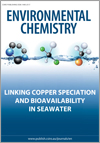Environmental context. Copper (Cu) is a metal of ecotoxicological concern in contaminated coastal areas. Cu present as the free ion is considered the most bioavailable fraction of the metal, and there is a need for the correct measurement or estimation of free Cu-ion concentrations in seawater. I review studies that have combined a biological measure of Cu bioavailability with chemical speciation measurements, and critically assess the ability of current methods to predict Cu bioavailability in contaminated coastal ecosystems.

Environmental Chemistry
Volume 17 Number 7 2020
Environmental context. Remediation of wastewater containing polycyclic aromatic hydrocarbons and metals is essential to limit adverse effects on the environment and human health. Using a simple precipitation method, we prepared porous magnetic MgO hybrids for use as a material for removing pollutants from wastewater. The material showed excellent removal performance for 12 polycyclic aromatic hydrocarbons and cadmium ions, and thus has potential applications in wastewater treatment.
EN20005Distribution and source estimation of polycyclic aromatic hydrocarbons in coastal sediments from Seto Inland Sea, Japan
 , Yoko Nunome, Hideo Yamazaki, Satoshi Asaoka, Kazuhiko Takeda and Hiroshi Sakugawa
, Yoko Nunome, Hideo Yamazaki, Satoshi Asaoka, Kazuhiko Takeda and Hiroshi Sakugawa 
Environmental context. Polycyclic aromatic hydrocarbons are carcinogenic environmental contaminants that tend to migrate into the sediments in oceans and seas. Their vertical distribution in sediments from the Seto Inland Sea matched their emission over time, which in turn reflected changes in energy sources and industrial activities in Japan. This study shows that human activities on land directly and significantly influence the concentration of polycyclic aromatic hydrocarbons in sediments.
Environmental context. A diverse range of materials contain organofluorine chemicals, some of which are hazardous and widely distributed in the environment. We investigated an inventory of over 4700 organofluorine compounds, characterised their chemical diversity and selected representatives for future testing to fill knowledge gaps about their environmental fate and effects. Fate and property models were examined and concluded to be valid for only a fraction of studied organofluorines.
EN19296 Abstract | EN19296 Full Text | EN19296PDF (1.5 MB) | EN19296Supplementary Material (3.2 MB) Open Access Article
Environmental context. Dimethylsulfoniopropionate and dimethylsulfoxide could have a climatic influence especially in the polar areas. We investigate the effect of sea ice salinity and temperature on the production of these two sulfur metabolites by a polar microalga, and suggest their potential roles of osmoregulator and cryoprotectant. These results bring new information about the sulfur cycle in sea ice that is useful for climate models.



